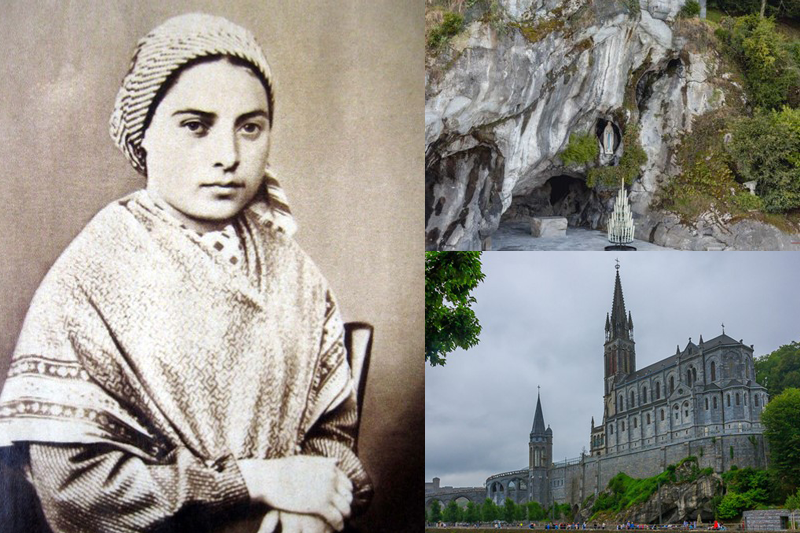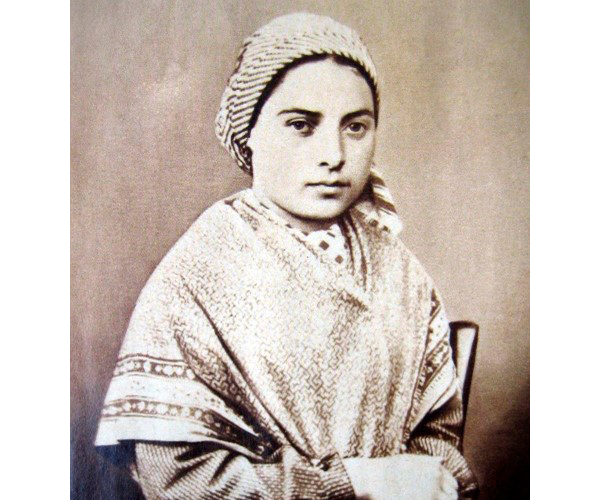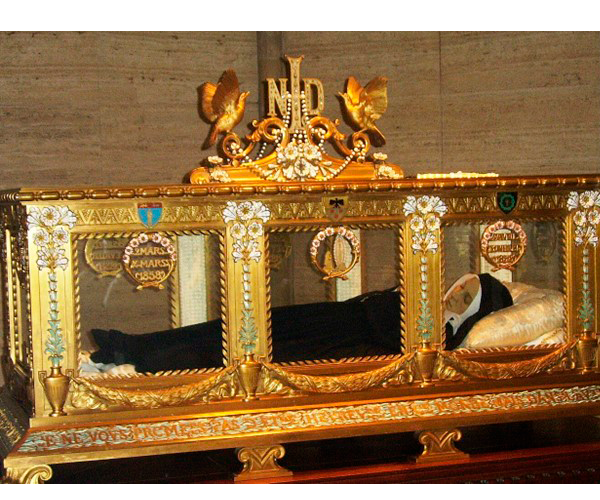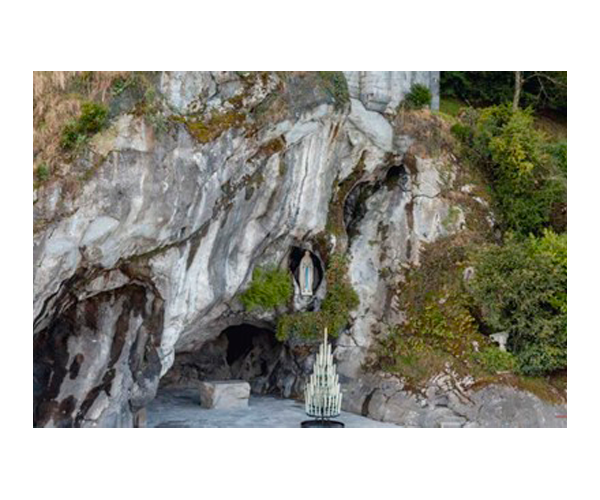Blogs

A Lesson in Limitless Faith
By Emma Donnelly
A rock called Massabielle towers over the Gave de Pau River near Lourdes, France. At 27 meters tall, it has a 4-meter grotto at its base and a niche in the rock above it to the right. On Feb. 11, 1858, 14-year-old Bernadette Soubirous, younger sister Toinnette and a friend, Jeanne Abadie, were gathering firewood near the base of the rock. Toinnette and Jeanne had removed their stockings to cross the river, but lamenting the cold, Bernadette hesitated at the mouth of the grotto before removing her stockings.
She heard a loud noise like a strong gust of wind blowing, but when she looked up, the trees across the river were still. When she heard it again, she turned her glance to the grotto behind her, and a warm, brilliant glow illuminated the niche above the cave. In the center stood a woman in white, smiling down at Bernadette. She had a blue sash around her waist and a yellow rose on each foot; in her hand was a rosary of pearls. Bernadette prayed the rosary, and when she finished, the woman had disappeared.
Bernadette joined her companions across the river and confided in them that she had seen a beautiful lady and made them promise not to tell, but as soon as they arrived home, Toinnette announced that Bernadette had seen a woman in white at Massabielle. Their mother forbade them to return.
Eventually, Bernadette’s mother relented, and the woman, whom Bernadette referred to as Aquerò, which means “that thing” in Bernadette’s local vernacular, Gascon Occitan, returned on Feb. 14 and Feb. 18. During the third apparition, Aquerò spoke her first words to Bernadette: Would she be kind enough to come every day for a fortnight (two weeks)? She also made a promise to Bernadette: She would not be able to make her happy in this world but could in the next. This vision signaled the beginning of the Holy Fortnight.
The Holy Fortnight
For the next 13 days, Feb. 19 through March 3, 1858, Bernadette returned to the grotto. During each visit, Bernadette was sent into an altered state of consciousness. Her face would become pale, and her eyes would remain fixed on the niche, her lips turned up in a smile. When Aquerò disappeared, Bernadette would return to consciousness with a message: Pray to God for the sinners.
The first miracle of the fortnight occurred on Feb. 25 before 350 onlookers who had accompanied Bernadette to the grotto. Aquerò told Bernadette to drink and wash herself in the spring. There wasn’t a spring near Massabielle, so Bernadette started toward the river, but Aquerò stopped her and pointed to the grotto. Bernadette began to dig through a puddle of mud and eventually hit water. The farther down she dug, the cleaner the water became. When she finished drinking and washing herself, Aquerò told her to eat some of the grass beside the spring in the name of sinners.
Horrified gasps rose from the crowd when Bernadette rose and faced them. Her face and body were covered in mud, and she was chewing on a tuft of grass. Her aunt, the family matriarch, dragged Bernadette home, and people jeered and laughed as she passed, some convinced she’d gone mad. Faith in her was restored the next day; the slow trickle of water had strengthened into a spring that still flows at the rate of 27,000 gallons per day. The spring at Lourdes has been associated with thousands of miraculous healings.
On March 2, Aquerò made her first official request: “Go and tell the priest to build a chapel here and to have people come in procession.” Although she was frightened by the strict nature of the parish priest, Father Dominique Peyramale, Bernadette relayed the request. He dismissed her, and she returned to him the next day. He berated her, stating that he wasn’t in the business of dealing with mysterious strangers. Then he demanded, “If the lady wants her chapel, let her tell you her name, and ask her to make the rosebush at the grotto flower.” When Bernadette first asked Aquerò her name, the only response she received was a smile, and the rosebush never bloomed. However, three weeks after the fortnight, on March 25, Aquerò said, “I am the Immaculate Conception.”
Bernadette didn’t know what that meant. The Immaculate Conception had only become Catholic dogma four years earlier, and like so many others in her town, Bernadette couldn’t read or write, so she had never heard the term before. Nevertheless, she immediately ran to Peyramale and informed him of what the woman had told her.
“Do you know what that means?” he asked her. Bernadette replied that she didn’t, and Peyramale sent her home without an explanation. That evening, Peyramale penned a letter to the bishop. “She could never have invented this,” he wrote. From then on, Peyramale was one of Bernadette’s biggest supporters.
Bernadette returned to Massabielle again on April 7, three days before Easter. Crowds were gathering daily at the grotto. Among them was the physician Pierre-Romain Dozous. When Bernadette arrived with a candle in hand and knelt at the mouth of the grotto, Dozous pushed his way to the front and stood beside her so he could study the events firsthand. While in her altered state, Bernadette unconsciously placed her left hand on the flame of the candle. Despite cries of horror from the crowd, Bernadette was unfazed. Her hand was in the flame for at least 15 minutes while she prayed. When she was finished and stood up, Dozous found no burns. Then, he took another lit candle and touched it to her hand without warning. Bernadette jerked her hand back and cried, “You are burning me!”
In time, fame-seekers claimed to have seen visions of the Holy Virgin and reported false miracles. The French government closed off Massabielle and issued harsh penalties for anyone who neared it, but the emperor Napoleon reopened Massabielle on Oct. 4, 1858.
On July 16, 1858, Bernadette was called to Massabielle for the last time. The grotto was still barricaded, so Bernadette stood on the far side of the river. Mary appeared once more in the niche. Despite being on the opposite side of the river, Bernadette felt as though Mary were right in front of her.
The Legacy of Lourdes
In 1866, at the age of 22, Bernadette joined the Sisters of Charity in Nevers, France, where she worked as an infirmarian and a sacristan. She died April 16, 1879, at the age of 34.
In 1909, 30 years after her death, Bernadette’s body was exhumed in the presence of two doctors, several appointed officials, and nuns from the Nevers convent. Her body had no signs of decay; 10 years later, a second exhumation took place, and her body was in the same state except for some discoloration in her face caused in the first exhumation. A wax worker was hired to preserve her beauty. Her body was placed in a glass and gold coffin, and it is now displayed at the Chapel of St. Bernadette in Nevers, France. It is venerated as a sacred relic of the Church.
Bernadette was declared a saint on Dec. 8, 1933. Mary’s request at Lourdes was honored in 1871, when construction of the Basilica of the Immaculate Conception — built above Massabielle — was completed. Every year, the basilica draws over 6 million pilgrims to its sanctuary. Over 7,000 unexplained cures have been associated with Lourdes, and the Catholic Church has declared 70 of them miraculous.
A lesson from Bernadette and Our Lady of Lourdes is one of selflessness and suffering, of compassion and love, of peace and understanding. Mary appeared to a girl in a poor town with prayers for sinners. Bernadette endured suffering for sinners without question or hesitation, reflecting the same faith that Mary showed Bernadette at Lourdes.
— Emma Donnelly ’26 is a history major and a student employee in the Marian Library.




